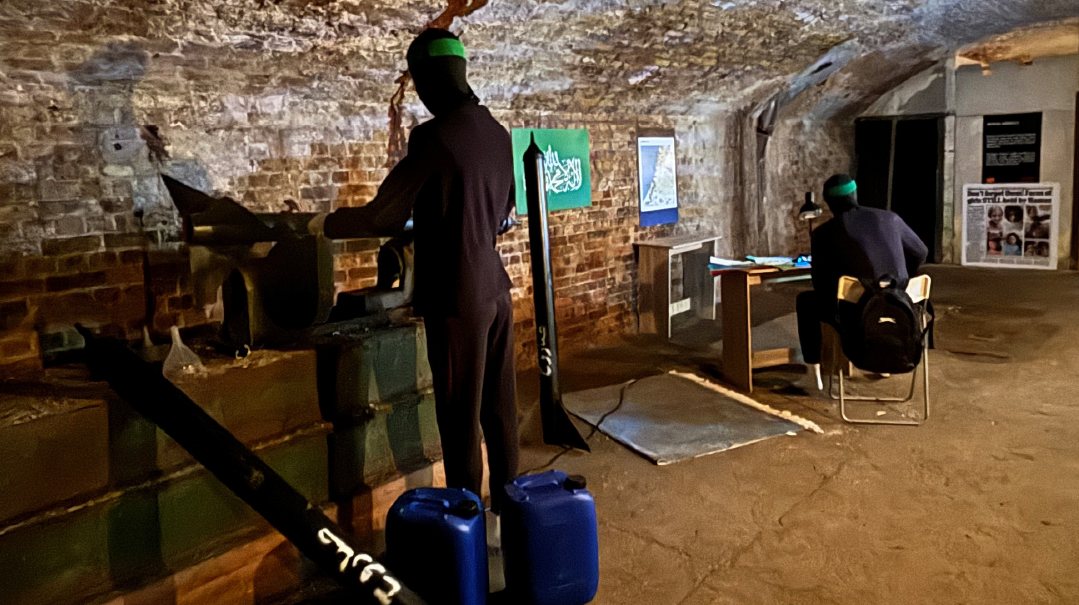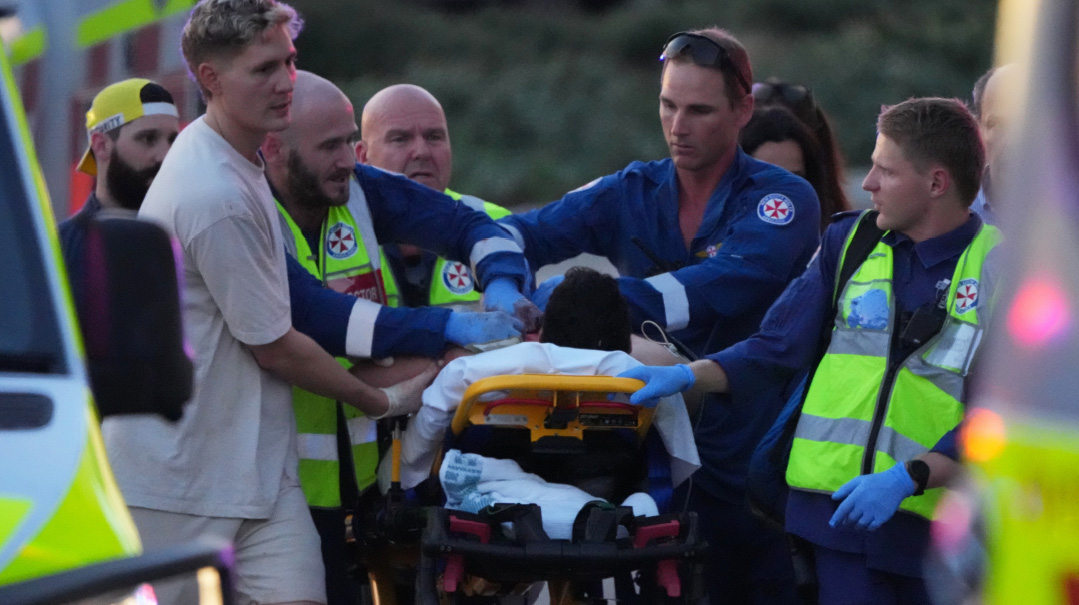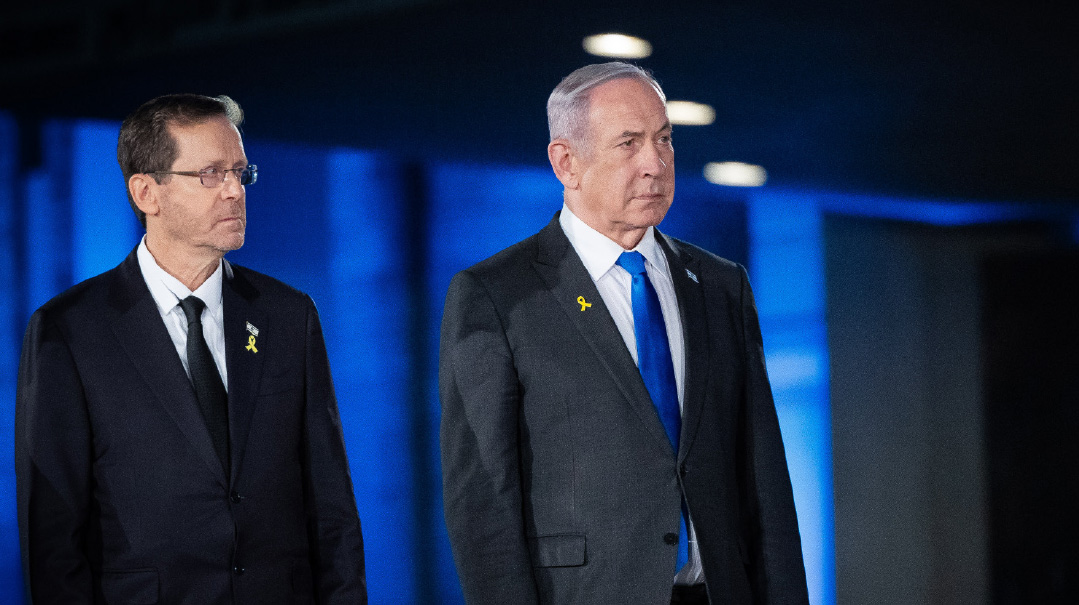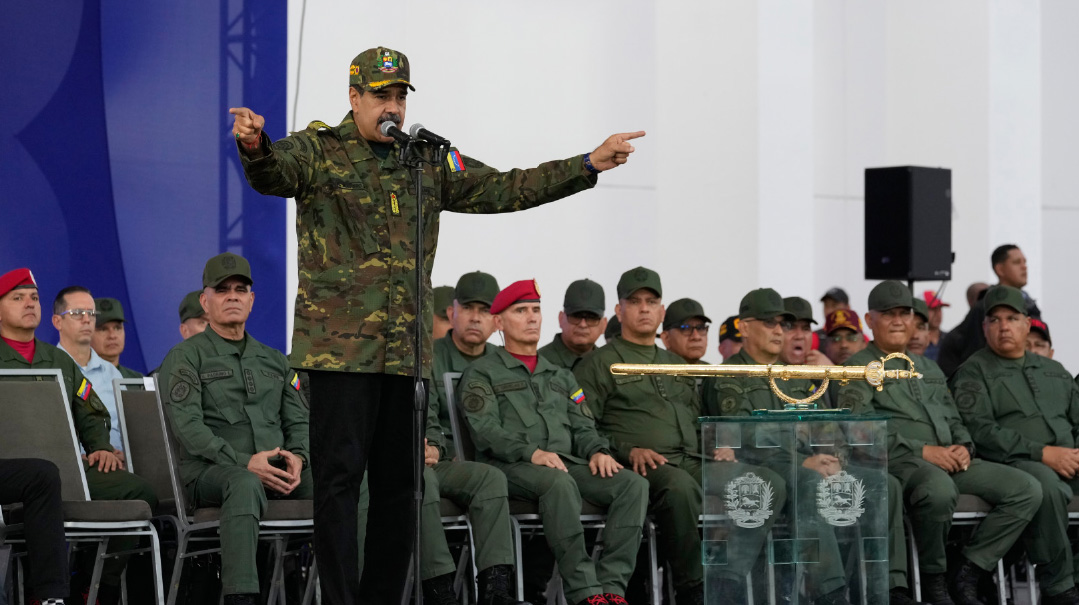London Underground
| January 23, 2024A haunting exhibit in the east of the capital educates British politicians and journalists about the horrors that the October 7th captives endure in Hamas’s tunnels

Photos: 7/10 Human Chain
The dank, claustrophobic basement of a derelict building in east London was the setting for an unusual exhibition last week. Organized by the 7/10 Human Chain Project, a grassroots group formed in the wake of Hamas’s October 7 blitzkrieg on Israel, the installation, titled “Voice from the Tunnels,” sought to bring to life the experience of Israeli hostages held underground in Gaza for more than 100 days.
The exhibition was open for five days to members of Parliament, celebrities, leaders of faiths and communities, senior CEOs of large corporations, journalists, social media influencers, and anyone else with a platform to highlight the plight of the remaining captives. The disturbing displays recreate the settings of the Hamas tunnels under Gaza, estimated to be at least 350 miles long — far exceeding the length of the London Underground railway system at 250 miles.
“It’s based on IDF evidence, it’s based on footage that was found, it’s based on interviewing the Hostages and Missing Families Forum,” says exhibit co-creator Orit Eyal-Fibeesh. “It’s really an attempt to portray, as accurately as we possibly can, some of those stories.”
The 7/10 Human Chain Project came from a nucleus of people who began putting up posters of hostages to publicize the October 7 kidnappings. The small group watched pro-Hamas activists tear down their posters and became more determined.
The group began holding demonstrations outside Parliament Square, Downing Street, and the London offices of the Red Cross and United Nations Women. It took the name 7/10 Human Chain Project after gathering enough people to form a human chain at one protest.
The group would remind passersby that hostage Emily Hand had turned nine years old in Hamas captivity. Little Emily has since been released, but her father, Thomas, has said in interviews that his daughter still cries uncontrollably, does not wish to be comforted by anyone, and only speaks in a low whisper. Emily, like the other children and women already released, left the tunnels traumatized, hungry, and alone.
Utter Overwhelm
On January 14, marking the hostages’ 100 days in captivity, the 7/10 Human Chain Project organized a rally in support of Israel that drew more than 25,000 people to London’s Trafalgar Square. The next day, the group opened the “Voice from the Tunnels” exhibition, an effort for which planning had been underway for many weeks.
The project came about after one of the organizers, who identifies himself only as David, decided to create a display of Hamas atrocities. David has a business that supplies mannequins to stores and theatres, and saw an opportunity to put his trade to use to help the hostages.
The display he developed, using mannequins that are human-like but essentially faceless, created a haunting impression that David wanted to capture. By that time, some of the hostages had been released, and horrific stories began to emerge.
The organizers spoke to doctors who had treated released hostages, as well as their family members, and also made use of video footage discovered in the tunnels that was released by the IDF. Everything in the group’s reconstruction of the Gaza tunnels was then verified and cross-checked with the Hostages and Missing Families Forum.
The exhibit, made accessible last week to members of the media, took the form of a tour that begins in a makeshift hospital environment. Beds are lined up in a large ward at ground-floor level, and at first glance resemble the setting in any other hospital. But as the tour makes clear, many of Hamas’s tunnels have been discovered underneath hospitals, schools, kindergartens, mosques, and even United Nations buildings. It is a reminder of the security cam footage discovered by the IDF that showed Hamas terrorists bringing hostages to a Gaza hospital on October 7.
As the tour heads below ground, project co-creator Orit Eyal-Fibeesh, serving in the role of tour guide (she is also a former IDF officer), informs guests that the actual Gaza tunnels are some 50 to 60 meters (170 to 200 feet) underground, running to five or six levels. The complex could only have been constructed with a mind-boggling quantity of concrete — not to mention engineering expertise.
The gut-wrenching part of the tour starts in earnest when it reaches a display of prone mannequins covered in a bloody white sheet, meant to recreate what the IDF discovered upon entering one of the tunnels in their quest for hostages. Apart from one female soldier, the rest of the hostages discovered on that day had been murdered.
The tour moves on to an introductory room, where TV screens display various media loops covering the unfolding events of October 7, followed by news coverage in subsequent days and weeks.
Little Kfir Bibas, kidnapped when he was just under nine months old (his birthday was on January 18), is mentioned in the coverage, along with his four-year-old brother Ariel. The oldest person still in captivity is 85.
At this point, two women appear next to Orit. They seem to have joined the tour, but Orit explains that they have just watched a 43-minute compilation of footage from Hamas body cameras retrieved by the IDF, along with video from kibbutz and police security cameras and that taken by soldiers.
The two women are both in total shock, so overwhelmed that they cannot speak, and they begin to cry. Orit starts sobbing herself, as she is familiar with the film. The two women cannot continue and need to leave.
Careful Preparations
Throughout the tour in the cold, damp, filthy tunnels, screams of “Allahu Akbar” repeat on a recorded loop taken from October 7. There are also recordings of the sound of bombing in the distance, believed to be from IDF bombs and shells.
Freed Israeli hostages have told doctors and family members that the shouts of “Allahu Akbar,” which echoed in the tunnels when terrorists came in pumped up with adrenalin, will not leave their heads. Hostages being held underground did not know if it was night or day. Their captors constantly told them, “No one is looking for you and no one knows you are here.”
On the tour, the screams of “Allahu Akbar” and the booms of nearby IDF bombing only last about 45 minutes — leaving it to tour participants to imagine what it would be like to be trapped there for more than 115 days with little or no food, no medication, no room to move, no showers, limited access to toilets, and terrorists brandishing automatic weapons.
Orit leads the tour into another tunnel, the floors of which are strewn with children’s pajamas, shoes, and clothes, baby bottles, diapers, and pacifiers. The IDF discovered such tunnels, proving that Hamas was preparing for this “operation” for a long time.
The IDF also determined that Hamas assembled detailed records of who was living in each house, their ages, nationalities, and more. The next room recreates a scene in which Hamas commanders, with their detailed paperwork, are giving instructions to the terrorists already in the kibbutzim as to who lives where.
The next room recreates Hamas’s crude operating theatre, where the hostages Maya and her brother Itai are highlighted. Maya was shot in the foot while she was taken hostage and has described how she was forced to walk on the wound more than two miles in the tunnels. Her brother Itai was also shot.
None of the Arab doctors wanted to operate on Jews, so a veterinarian was brought in to perform the complicated operation on Maya. In what has been well documented, Maya’s foot was sown up the wrong way, while Itai was operated on without any anesthetic.
Next is the Hamas command center, where operatives prepare to fire more rockets into Israel. There is a Koran and a prayer mat. In another room, a young boy is depicted sitting on the ground in front of a TV screen. This is Eitan Yahalomi, aged 12, who was kidnapped with his mother and sister on two separate motorbikes.
The mother and sister managed to escape when one of the bikes hit a tank. Eitan was on his own, and once he was in Gaza, he was made to watch some of the footage of Hamas’s barbaric atrocities. If Eitan started to cry, they threatened him with pain and death. He spoke fluent Arabic when he was released from Gaza after 50 days.
The stories of the elderly hostages are just as horrific. Emma was released more than two months ago, but remains in the hospital. She was taking medication to manage a health problem before being taken hostage. Since being released, Emma’s organs have failed because of the conditions in which she was held.
Many of the tunnels did not have high ceilings and the elderly had to walk crouched over for miles in the damp, dark, and wet tunnels. The older people were forced to sleep on the floor. They had to wait 12 hours before using the toilet.
Forced into Hiding
Noam Sagi, a son of a 74-year-old hostage from Kibbutz Nir Oz who was released, visited the London tunnels last week and attested that it was an accurate depiction. His mother turned 75 in captivity. She was one of the lucky ones; she was sold by Hamas to Islamic Jihad and then taken above ground and held in a family home.
Ada, another hostage, was also sold to Islamic Jihad and held above ground. Before October 7, she lived on the border and spoke fluent Arabic, as she was an Arabic teacher, and she believed in peace with her neighbors. She refuses to speak to the media today, but a family member says she will eventually write about her captivity.
Orit Eyal-Fibeesh says many of the hostages suffered from chemical burns because they were not allowed to shower even once, the entire time. Doctors discovered they were drugged, probably with Ketamine, which is used to induce a state of sedation and immobility.
The exhibition is a collection of images that cannot be unseen. The fact that the event was essentially forced into hiding — open only to politicians and journalists at a secret location in London — testifies loud and clear about the violent anti-Semitism that has taken hold in the UK.
As Hamas’s supporters dominate the streets of central London in weekly marches, any reminder of Jewish humanitarian suffering in Hamas’s torture tunnels has essentially been driven underground.
(Originally featured in Mishpacha, Issue 996)
Oops! We could not locate your form.






